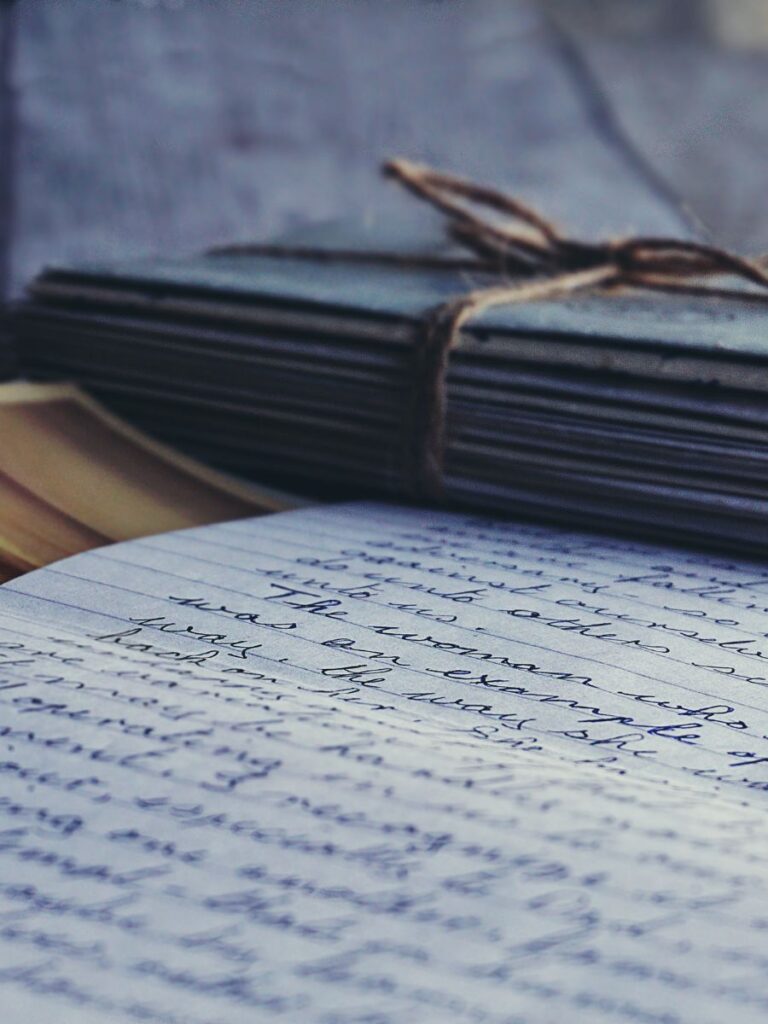How to write a letter you will never send: The Unexpected Healing of Writing Letters


Feeling heavy about a mistake?
Letting go of a relationship?
It might be time to write a letter you will never send.
Here we peel back our ego, that layer of protection, to reveal our true feelings beneath, in this therapeutic exercise.
Why Write a Letter That You’ll Never Send
There is a certain cathartic release that comes with writing a letter that you’ll never send. When emotions overwhelm us, it can be difficult to find the right words to express ourselves to someone else. Sometimes we aren’t able to get the closure we feel we need, words have gone unsaid, or someone has passed away and we are not able to directly speak to them.
Through the act of writing, we can pour out our thoughts and feelings from inside our minds onto paper, even if it’s just for ourselves.
Writing an unsent letter allows us to acknowledge our deepest emotions, validating our experiences and giving them a tangible form. It offers a safe space to be vulnerable and raw, without the fear of judgement or rejection.
There is a sense of relief in getting everything off our chest, knowing that we have expressed ourselves honestly, even if only to ourselves.
Sometimes, the act of writing a letter that we never send can be a form of ”good-enough” closure, helping us let go of unresolved feelings and moving forward. It becomes a therapeutic practice of self-reflection and healing, allowing us to process our emotions and find inner peace.
Why Express Feelings in a Written Format?
Can’t say it out loud?
Overthinking it?
Write it out.
Writing has always been a powerful medium of expression. It’s therapeutic to write a letter, the physicality of using our hands, pouring out our thoughts and feelings onto the page.
Sometimes, the words we struggle to say out loud become easier to put on paper. Letters offer a sense of release, allowing us to communicate our deepest emotions without the fear of judgment or interruption. It’s liberating to let the ink flow freely, knowing that these words may never be sent.
They serve as a cathartic release, a way to connect with our own selves on a deeper level.
Writing provides a layer of protection, allowing us to peel back the self-consciousness that often holds us back. Deep beneath this layer, our true thoughts and inspirations come to life.
In an instant, the weight of unspoken words vanishes, providing solace and healing. Whether it’s to a friend, a lover, or even a therapist, the act of writing allows us to process our emotions and find clarity in our intentions.
So if you can’t say it, don’t hesitate to write it.


Therapeutic benefits of writing letters
Writing unsent letters can provide numerous therapeutic benefits.
The act of writing allows individuals to express their thoughts, feelings, and emotions in a safe and unfiltered manner.
Whether it’s writing a letter to a loved one or to oneself, the process of putting thoughts onto paper can be incredibly healing. When we write a letter, we have the opportunity to reflect on our emotions and thoughts, helping us gain a deeper understanding of ourselves and our relationships.
Additionally, writing an unsent letter, also known as a “letter you will never send,” can provide a sense of closure and release.
By putting our thoughts and feelings into words, we can release any pent-up emotions and find a sense of clarity and peace. The intention of sending a letter can also be therapeutic, as it allows us to affirm our feelings and thoughts and create a deeper connection with the recipient.
Ultimately, the act of writing letters can provide countless therapeutic benefits, fostering healing, introspection, and self-discovery.
A recommended tool for self-expression and self-discovery
Writing unsent letters can be a cathartic and therapeutic practice. It allows the writer to express their feelings and thoughts without the immediate pressure of sending them.
The act of putting pen to paper and pouring out emotions onto the page is a way to release pent-up anger, sadness, or any other intense emotion. Writing unsent letters also gives the writer the opportunity to reflect on their own growth and development.
When looking back at drafts of previous selves, the writer may realize how their thoughts and feelings have evolved over time.
It is an exercise in self-reflection, where one can pretend to have a conversation with the intended recipient, or even themselves. This process can provide a sense of closure and may bring the writer the courage to confront situations or mistakes that were once too daunting.
Additionally, writing unsent letters can reveal underlying emotions and thoughts that were previously hidden or unrecognized. It can bring about a sense of release and provide an outlet for the writer to process and make sense of their feelings.
How to Write an Unsent Letter: Simple Exercise Steps
1. Set the scene
To write an unsent letter, first, you need to begin by finding a quiet and comfortable space where you can focus on your thoughts and emotions.
I recommend time-capping this process, from 30 minutes up to 1.5 hours, for you to write, take breaks or pause, and continue. It’s important to time-cap so you don’t spend too long in this emotional space ruminating or getting caught in a thought-spiral. You can set a timer on your phone if needed.
2. Reflect and open up
Notice any feelings that arise in your body as you reflect on the situation or person you want to address in the letter.
Then, imagine yourself holding onto those emotions and allow them to flow freely onto the paper.
When writing an unsent letter, there’s no need to hold back or censor yourself. Let your thoughts and feelings be unfiltered and raw, as this letter is for your eyes only.
Be honest with yourself and express exactly how you feel, without the fear of judgement or consequences.


3. Dig a little deeper with mind and body connection
Take some time to think about what happened and how it impacted you, both mentally and physically.
Check-in with the body, anywhere that feels tense, anxious or energised as you revisit your feelings. Noticing any sensations that arise in your body as you revisit and recall the events can provide valuable insights into your emotional processing.
Gently observe any unhelpful or judgmental thoughts in this process – these may have held you back previously from expressing yourself or from feeling your raw and honest emotions.
Throughout the letter, remind yourself that this is a space for you to express your true feelings without holding back, notice resistance and allow yourself to continue speaking freely.
Remember, you don’t have to send this letter. Its purpose is to help you process and release emotions that may be weighing you down. So be gentle with yourself and allow the words to flow freely onto the paper, offering yourself a cathartic release.
4. Finished? Not quite…
Once you have completed your letter, check in again with how the body is feeling:
Do you need to move the body? Stretch? Shake it out?
Honour this and notice how it feels.
Now, think about what you’d like to do with the letter.
You can burn it, rip it up, fold it neatly and tuck it away in a diary to revisit at a later stage. It’s complexly up to you.
Know that whatever you decide is also part of this process. For example, if you feel the urge to rip up the letter, what does that say about your relationship to the letter? to the feelings written in it? or to the person it was addressed to?
The ripping may be a need for catharsis, an expression of anger, or even liberation from pain.
Lean into what feels good, or feels right for you and accept that as part of your processing.
5. Rest & repeat when needed
Remember that this is a process and this exercise may help aid some of your healing but is not aimed to resolve or fix everything you are going through.
It may be that one letter wasn’t enough, multiple may be needed after letting the dust settle from your first go of the exercise.
We often find after conversations with others that further thoughts or reflections come up. The dreaded ”I wish I had said that” or ”Why didn’t I realise this at the time?”
This is normal, we can’t always anticipate how we will process things before we have begun the processing.
You’re welcome to revisit this exercise and write another letter at another time if needed.


Final Thoughts: A necessary disclaimer
This internal process can be revealing and confronting, so it’s recommended you do this alone with deep and unaddressed trauma. Although this can be deeply helpful for trauma processing, it’s recommended you do this under the support of a licenced mental health professional or similar alternative.
The various emotions that emerge can take time to settle after an exercise like this when addressing trauma. Having this extra support creates a supportive ‘holding’ space for any unearthed trauma processing.
We can do some amazing solo healing work but it’s always important to understand:
- when to ask for help
- when going it alone is unwise
- when the need for a professional is present
We hope you enjoy this exercise and reuse time and time again in your personal journey.
Looking for more support?
Hi, I’m Tanisha the creator and writer for Loving Therapy Project and a licenced Mental Health Professional.
I use this hub of resources, and my private practice The Global Therapy Room, to provide international, accessible support options for people all over the world.
From the articles and free resources you can see here, to the events and live workshops throughout the year – support is available in many forms.
Learn the skills, tools and inner working you’ve needed to live a freer, balanced life, liberated from trauma.
Head over to the Event & Workshops page for upcoming offerings and more free tools for you to use.
Frequently Asked Questions
Q: How can writing letters be healing?
A: Writing letters can be healing because it allows you to express your emotions, thoughts, and feelings in a safe and private space.
Q: How can writing letters you’ll never send be helpful in dealing with a past relationship?
A: Writing letters you’ll never send can be helpful in dealing with a past relationship because it allows you to express your emotions and thoughts without the fear of judgment or negative consequences. It can provide a sense of closure and provide a space for reflection and healing.
Q: Can writing letters you’ll never send help in getting over an ex?
A: Yes, writing letters you’ll never send can help in getting over an ex. It can be a form of catharsis, allowing you to release pent-up emotions and gain clarity on the situation. Writing can also provide a sense of closure and help you move forward.
Q: Is there a specific format or structure for writing letters you’ll never send?
A: There is no specific format or structure for writing letters you’ll never send. You have the freedom to write in any way that feels authentic to you. The important thing is to express your emotions and thoughts honestly.
Q: Can writing letters you’ll never send be therapeutic?
A: Yes, writing letters you’ll never send can be therapeutic. It allows you to release emotions, gain insight into your feelings, and process past experiences.
It can be a form of self-therapy and a way to promote healing.
Q: Can writing letters you’ll never send benefit anyone else?
A: While writing letters you’ll never send is primarily a personal and private practice, it can benefit others indirectly.
By exploring your own emotions and experiences through writing, you may gain insights and wisdom that could be shared with others in the form of advice or support.
Q: Is it important to keep the letters you’ll never send private?
A: Yes, it is important to keep the letters you’ll never send private.
The purpose of writing these letters is to have a safe space to express yourself without the risk of causing harm or escalating conflicts. It is not intended for the recipient to read.
Q: Can writing letters you’ll never send be a form of therapy?
A: Writing letters you’ll never send can be a form of therapy, particularly in dealing with emotions, trauma, or past experiences. It allows you to process and express yourself in a controlled and introspective manner.
Q: Are there any potential downsides to writing letters you’ll never send?
A: While writing letters you’ll never send can be a helpful practice, there are potential downsides. It is important to be aware that dwelling too much on negative emotions or past experiences can hinder personal growth and healing.
It is always recommended to seek professional help if needed.





Pingback: The Power of Forgiveness: Letting Go of Anger and Resentment for a Happier Life